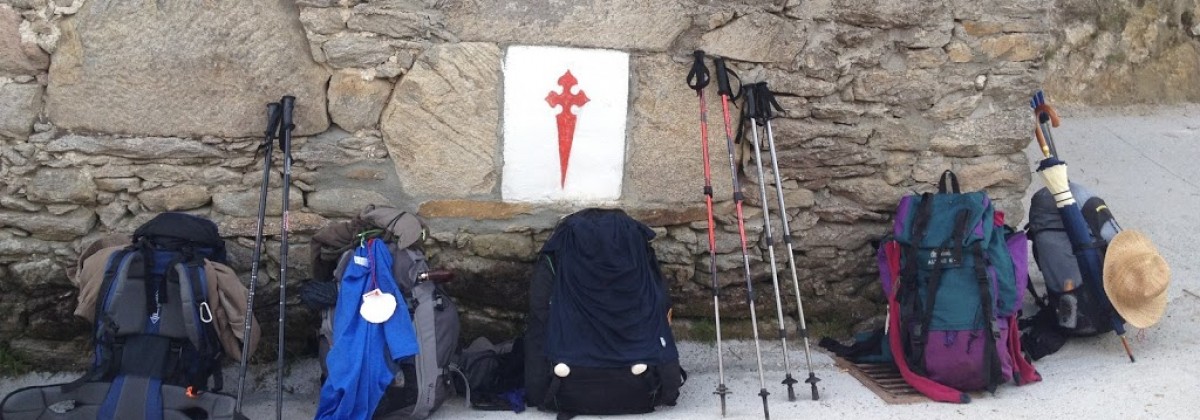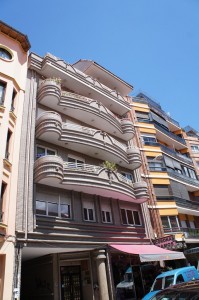as befits a still-grand city, León’s origins date from the Romans who established a military outpost here in the year 70 to protect gold mines and it later became the seat of the VIIth Legion and capital of the empire in northwest Spain. a massive wall, remains of which still mark the limits of the old town, encompassed the Roman settlement. that wall, along with some baths under the cathedral are the only structures that remain from that period.
 fortunes in the city ebbed and flowed with the decline of the Romans, incorporation into the kingdom of Asturias, conquest by the Visigoths (in 585), and then the Moors (712) under whose control it remained for over a century. in 746, Ordoño I managed to extricate the city from Moorish control and his successors invited Mozarabic refugees (Christians who hadn’t fled their lands and chose to remain under Moorish rule) from farther south to repopulate the city. despite the success of Ordoño and his immediate successors in building León up as a Christian city (and transforming the Kingdom of Asturias into that of León) — establishing churches, granting land to the bishop to construct a cathedral over the Roman baths, relocating the Asturian court and building a royal palace — subsequent generations proved weaker-willed and in the 10th century monarchs were paying protection money to caliphs in Cordoba to maintain “peace.” evidence of the 10th century prosperity vanished in 988 when the king, seeking aid from his “protectors” to defeat a rebellious brother, essentially invited an attack and occupation. in the 11th century, Alfonso V began a successful campaign to wrest control of Spain from Moorish control and his success led to eventual unification of the Castillian and Leonese crowns (as discussed in a previous post). by the middle of the 14th century, however, economic and political activity had shifted elsewhere as more and more of Spain fell under Christian authority. a series of continent-wide cataclysms, culminating in the arrival of the bubonic plague in 1349 or 1350 decimated León and effectively stunted its importance and growth for several centuries.
fortunes in the city ebbed and flowed with the decline of the Romans, incorporation into the kingdom of Asturias, conquest by the Visigoths (in 585), and then the Moors (712) under whose control it remained for over a century. in 746, Ordoño I managed to extricate the city from Moorish control and his successors invited Mozarabic refugees (Christians who hadn’t fled their lands and chose to remain under Moorish rule) from farther south to repopulate the city. despite the success of Ordoño and his immediate successors in building León up as a Christian city (and transforming the Kingdom of Asturias into that of León) — establishing churches, granting land to the bishop to construct a cathedral over the Roman baths, relocating the Asturian court and building a royal palace — subsequent generations proved weaker-willed and in the 10th century monarchs were paying protection money to caliphs in Cordoba to maintain “peace.” evidence of the 10th century prosperity vanished in 988 when the king, seeking aid from his “protectors” to defeat a rebellious brother, essentially invited an attack and occupation. in the 11th century, Alfonso V began a successful campaign to wrest control of Spain from Moorish control and his success led to eventual unification of the Castillian and Leonese crowns (as discussed in a previous post). by the middle of the 14th century, however, economic and political activity had shifted elsewhere as more and more of Spain fell under Christian authority. a series of continent-wide cataclysms, culminating in the arrival of the bubonic plague in 1349 or 1350 decimated León and effectively stunted its importance and growth for several centuries.
population growth stagnated until 19th century; most of the increase came down to influx from surrounding farming communities after the arrival of the railroad in the 1860s, in search of alternative means of employment. throughout the 20th century the population of the city grew rapidly — from about 21,000 inhabitants in 1920 to a peak of over 147,000 in 1995 — still due primarily to rural exodus.
the Leonese language is considered extremely endangered (more nearly extinct) by UNESCO, though the movement to attain Leonese autonomy from Castilla has made an effort to revive it. in 2006, the provincial government approved a Leonese Language Day as advocated for by a variety of language associations. as we proceeded farther along the Camino and away from Castillian influence we saw more and more graffiti promoting independence for León. I assumed the ” Llión Solo” signs we saw stemmed from an autonomy movement like the one in the Basque country, but hadn’t any confirmation of that until now. the University of León established a teacher training course in the Leonese language in 2001 and there are both adult-education courses in the language and lessons at high schools around León.
 it seems like León has a good history of protest and procession (you know, like events during Semana Santa) (maybe it’s just a Spanish and/or European thing to go out for a protest of a Saturday?); there was a notable rebel population here during the Franco regime, though a failed attempt at fomenting popular unrest resulted in the arrest and execution of a number of rebel organizers in 1936. when we were out at lunchtime in Saturday, a clump of bicyclers and pedestrian-types streamed past us down the middle of a major road –led by a police vehicle as often happens in the U.S. with permit-holding protesters, headed farther into town to join some kind of protest. based on the protest attendees in the plaza, it must have been something to do with cyclist and/or pedestrian safety and awareness.
it seems like León has a good history of protest and procession (you know, like events during Semana Santa) (maybe it’s just a Spanish and/or European thing to go out for a protest of a Saturday?); there was a notable rebel population here during the Franco regime, though a failed attempt at fomenting popular unrest resulted in the arrest and execution of a number of rebel organizers in 1936. when we were out at lunchtime in Saturday, a clump of bicyclers and pedestrian-types streamed past us down the middle of a major road –led by a police vehicle as often happens in the U.S. with permit-holding protesters, headed farther into town to join some kind of protest. based on the protest attendees in the plaza, it must have been something to do with cyclist and/or pedestrian safety and awareness.



